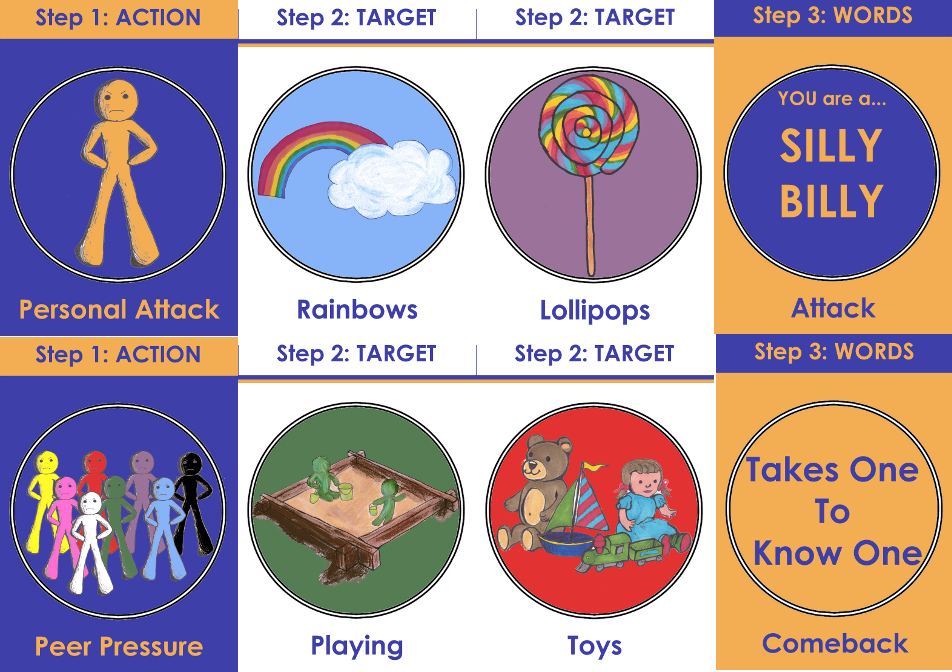Meaning of Life SissyFight Card Game
This game was inspired by my game idea a week project, in particular, idea 23. Pit yourself against your friends as you pretend to be kids arguing over the Meaning of Life. Make alliances or backstab your way to winning the argument.

This is a game for 3-8 players. Players start with 9 Argument cards and a set of Action/Target/Words cards. Every player secretly chooses a type of action (peer pressure or personal attack), a target (one of the other players) and the words they want to say (an attack or a comeback). The players then turn over their choice simultaneously. This results in some players loosing Argument cards. When a player looses all of their Argument cards, they are out of the game. When only two players remain, the other players vote for their favourite remaining player. The player who has the highest combination of votes and remaining Arguments wins.
Players can attack others either on their own (personal attack) or with others (peer pressure), which damages the target more. To defend themselves, players can choose a generic defence which halves the number of cards they will loose. Or players can create a Comeback for their would-be attackers. If the Comeback successfully targets an attacker, the attacker will loose an Argument, not the person being attacked.
The cards are frivolous and childish to match the theme that the players are supposed to be children. This encourages players not to be too serious about their argument and gives them permission to be bitchy and act in a way that would not be socially appropriate in the real-world.
To play this game you will need to:
- Download the zip file containing rules and cards and print them;
- Buy card protectors for the cut up cards (available from games shops).
Meaning of Life SissyFight
A game for 3-8 players.
(An adapted version of SissyFight 3000 from the Game Design Workshop at GDC 2010)
Players are young children debating the meaning of life according to them.
Each player starts with:
- 9 Argument cards (arrange these in front of the player to make a shape);
- One set of 12 coloured cards to match their Argument:
- 2 Action cards: 1 Personal Attack card and 1 Peer Attack card;
- 8 Target cards: One for each of the other players, and one "no target" card;
- 2 Words cards: 1 Word Attack card and 1 Word Comeback card.
The game is played in rounds.
Every round, each player secretly chooses one Action, one Target, and one Words card.
All players reveal their chosen cards simultaneously.
After revealing cards use the following rules to determine who looses Argument cards:
- Attacks:
- Personal Attack: Target looses 1 Argument, unless the target has a matching Comeback.
- Peer Attack: If two or more people target the same person, the target looses 2 Arguments for every person in the peer group. Unless the target has a matching Comeback.
- Comebacks
- Non-targeted Comeback: If you are targeted by any attack, you loose half of the Arguments you were supposed to loose. If you are not targeted by an attack, you loose one Argument card. Note that for this move the Action (peer or personal) chosen is irrelevant.
- Personal Comeback: If the target has attacked you (either peer or personal), then they loose 1 Argument. You loose nothing from the target, but can loose from other attacks. For example, if three people ("Playing", "Family" and "Rainbows") peer attack "Lollipops", and "Lollipops" uses a personal comeback on "Playing", then "Playing" looses 1 Argument, "Family" and "Rainbows" loose nothing, "Lollipops" looses 4 Arguments (2 for each of "Family" and "Rainbows").
- Peer Comeback: If the target is someone who is peer attacking with others, then everyone in the peer group looses 1 Argument. You loose 1 Argument for every person in the group. If the target is not in a peer attack, then your Comeback fails.
Once you have no more Argument cards, you are out of the game.
When there are two players (or fewer) remaining, the players who are out of the game vote for one of the remaining players. The remaining players get a score based on the number of votes received and the number of Argument cards still in front of them. The player with the highest score wins the argument!